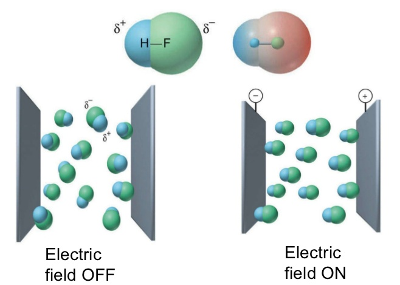We have all seen the following diagram (or similar) in our first chemistry class, depicting polar molecules aligned in an electric field. Is this just one of the half-truths of beginner chemistry or is this what really happens? I realize there will still be kinetic motion (spin, etc), but even statistically, is it possible for such a fluid/gas to have a net directional orientation throughout?
I have often seen the diagram depicted with water, but as the top answer on this question explains:
"...the ions will rush to the respective electrodes and form the so-called electric double layer. Its thickness, known as Debye length, is usually quite small. As for the rest of the solution, it will be effectively shielded from the electric field."
Perhaps this would be the same issue with hydrogen fluoride?
Is it possible the Debye length would be longer for a polar covalent molecule like Acetonitrile or Chloromethane?
If there are in fact polar molecules that exhibit this field-orientated behavior on a macro scale, what would be a way that it could be demonstrated?

